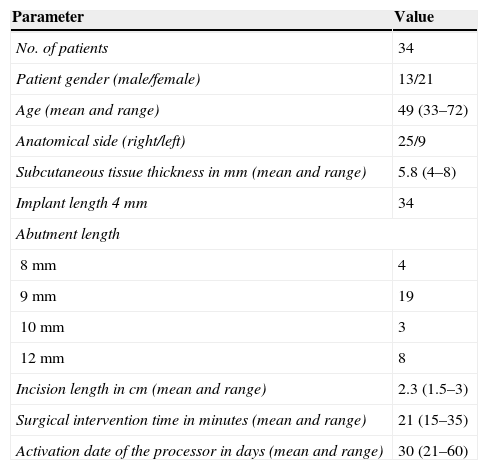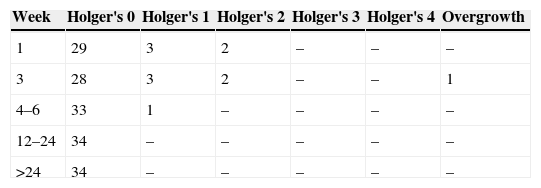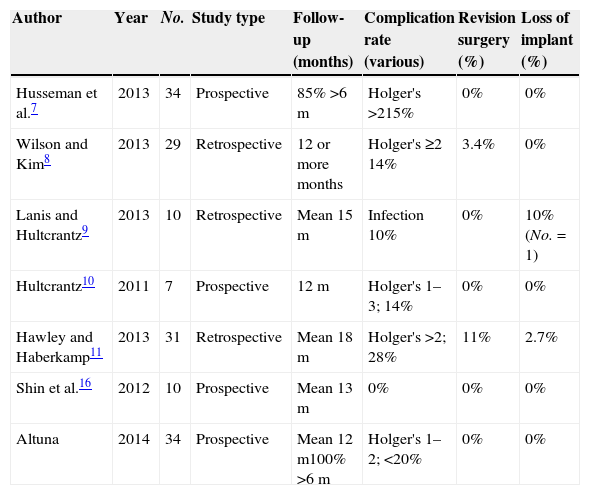The classic surgical procedure for percutaneous bone-anchored hearing devices involves removal of a large area of subcutaneous tissue down to the periosteum. This leads to alopecia and raises the risk of devascularization of the overlying skin with the potential for infection and scarring.
The objective of this study was to determine the results of implant placement using a single, linear incision with no underlying soft tissue reduction.
Material and methodA prospective study was conducted in our hospital over a period of 14 months in all consecutive surgeries performed using this technique in adults. Patients were reviewed regularly (week 1, week 3, weeks 4–6 and months 3, 6 and 12) to assess wound healing including evaluation with the Holgers scale.
ResultsCorresponding to 34 patients, 34 cases were consecutively enrolled in this study. We found that 15% of the patients had minor skin reactions during the first visit (Holgers grade 1 or 2); this number raised to 20% in week 3, but at week 4 only 1 patient had a reaction score of 1 (which was solved by week 6). None of the cases required revision surgery and all skin reactions were treated topically.
ConclusionsOur results suggest that the tissue preservation technique is a simple and effective insertion technique with a favourable healing process and cosmesis.
La técnica quirúrgica clásica para la colocación de los implantes osteointegrados percutáneos implica la reducción del tejido subcutáneo hasta el periostio y esto ocasiona algunas alteraciones estéticas y sensitivas en el área del implante además de las no poco habituales complicaciones infeccioso-inflamatorias locales.
El objetivo de este estudio es el análisis de los resultados empleando una técnica de incisión lineal sin reducción de tejido subcutáneo.
Material y métodoSe realiza un estudio prospectivo de los pacientes de edad adulta intervenidos por medio de esta técnica en nuestro hospital en un período de 14 meses. Se realiza un seguimiento anotándose los hallazgos en la zona periimplante según escala de Holgers en la semana 1, semana 3, semanas 4-6 y a los 3 meses, 6 meses y 12 meses poscirugía.
ResultadosTreinta y cuatro casos consecutivos fueron intervenidos que corresponden a 34 pacientes. Respecto a la irritación periimplante, se aprecia que un 15% de los casos presentan un Holgers 1 y 2 en la primera semana, un 20% en la semana 3 y a partir de la semana 4 solo un paciente presentaba un Holgers 1 que se resolvió en la semana 6. Todos los casos de irritación respondieron a medidas tópicas y no se requirió reintervención en ningún caso.
ConclusionesNuestros resultados indican que esta técnica quirúrgica, además de simplificar la cirugía, favorece la cicatrización y disminuye el número de reacciones colaterales que pueden verse en los casos operados con la técnica tradicional.











